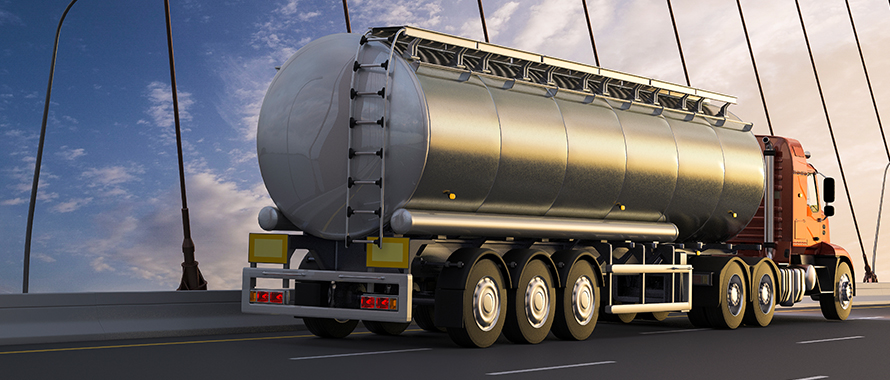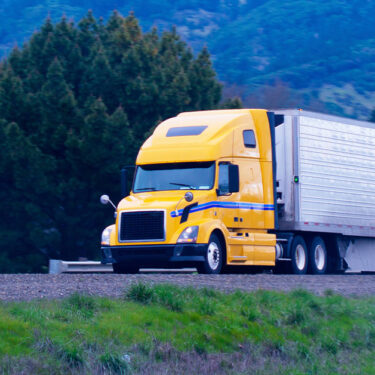Several homes were evacuated on February 3 after a semi-truck tanker overturned near Williamsburg, Kentucky and leaked 5,000 gallons of highly flammable butyl acrylate onto the railroad tracks below. Several agencies responded to the incident, including a hazmat crew to clean up the strong-smelling irritant.
While officials reported the risks of the chemical spill spreading beyond the site were low, they expressed concerns that the spilled substance could cause an explosion or respiratory issues for nearby residents. The roadway was closed to traffic for several hours as the tanker and chemical spill were cleared.
The truck driver reportedly told investigators his GPS misrouted him to the bridge and the tanker overturned as he attempted to turn it around. Fortunately, he escaped injury and no other injuries were reported. Evacuees were allowed to return to their homes that afternoon and the road was reopened to traffic that evening.
As John McGlynn, Director of Transportation, Burns & Wilcox, Toronto, Canada, observed, clean-up costs alone in the Kentucky bridge incident could be considerable if replacement of the railroad tracks or remediation for the soil were necessary, which could disrupt business operations for companies shipping their goods along that route and impact supply chains.
Gene’ Cain, Broker, Transportation, Burns & Wilcox Brokerage, Atlanta, Georgia, recommends a three-pronged strategy to protect against risk: utilize advanced technology, identify and implement best practices, and consult experienced and knowledgeable insurance brokers and agents.
Cain advises trucking operators to avail themselves of technology such as monitoring software, collision avoidance systems and in-cab camera systems to support accident prevention efforts, inform accident investigations and mitigate liability risks.
“I think for the long-term benefit of an organization and the long-term safety of the public, investing in that kind of technology is vital,” he asserted.
Rising risks and legal costs exacerbated without adequate coverage
According to McGlynn, a troubling current trend is trucking operators reducing their liability coverage to cut costs. Pervasive litigation across the transportation industry, he explained, has driven up risks and legal costs and, consequently, some insurance premiums.
“Five to seven years ago, a small fraction of bodily injury cases would have gone to trial,” McGlynn stated. “Now, more cases are going to trial with more advanced negotiations.” According to Cain, the sharp increase in the number of claims going to trial has led to skyrocketing numbers of so-called “nuclear verdicts,” which he defined as jury awards of more than $10 million to a plaintiff in a bodily injury case.
A customized Trucking Insurance bundle could include several policy types, some with coverage for mitigating costs of the damaged truck or hauler, such as a Physical Damage policy, and others with coverage for mitigating costs incurred when events involve bodily injury and prompt legal action.
Coverage under an Automotive Liability Insurance policy helps with payments for claims involving injuries to other motorists or their vehicles, structural damage to a nearby building caused by debris, and more. According to Cain, automotive liability is the biggest risk facing trucking operations.
Companies hauling goods are often required to carry Cargo Insurance, which generally assists with payments for damages or destruction of any items in tow. A Truckers General Liability policy is often needed to cover costs such as accidents that occur in parking lots, mishaps while loading or unloading and theft and vandalism.
An Environmental and Pollution Liability Insurance policy is often added to help shoulder cleanup costs when accidents involve spilling any substance determined to be a pollutant.
McGlynn pointed out that while Burns & Wilcox underwrites Truckers General Liability and Automotive Liability Insurance coverage limits that address the special risks faced by trucking operations that transport hazardous materials, most carriers have reduced these limits. Consequently, policyholders often choose to accept lower limits or invest in Excess Umbrella coverage to meet their coverage needs.
McGlynn asserted that trucking operations that reduce coverage limits to control costs are gambling that accidents or other events involving millions in legal costs and damage claims will not happen to them. “Risk has not decreased; it has only increased,” McGlynn asserted. “The cost of protecting oneself has followed that trend.”
Being underinsured could have serious financial consequences on a trucking operation, McGlynn warned. “If an operation were underinsured, it could conceivably be forced into bankruptcy because it lacked sufficient limits in insurance to satisfy a legal judgment or other demand for payment following an accident,” he said.
Accident frequency reflects trucking’s outsize role in economy
Large truck accidents regularly create safety concerns on U.S. and Canadian highways. These concerns are magnified when hazardous materials are involved.
Last October a large section of Highway 32 in western Alberta was shut down after a collision between a truck and another vehicle resulted in the spill of petroleum distillates, a flammable liquid that can cause headaches, dizziness and nausea. No injuries were reported, but because of the hazardous nature of the spill the highway remained closed for hours.
The environmental and health risks posed by hazardous material spills are well known; however, spills involving cargo not considered hazardous regularly pollute the natural environment and can even pose a threat to animals and humans living near affected sites.
On February 7, a semi tractor-trailer carrying 42,000 pounds of pig parts flipped over on Highway 59 in Rosenburg, Texas, creating a massive health and environmental hazard and snarling traffic. That same day, two separate transport truck accidents—one spilling up to 1,000 gallons of molasses and the other spilling a dump truck load of gravel and dust—occurred hours apart on the same stretch of Highway 101 in Santa Rosa, California.
Last month Canada’s busiest roadway—Highway 401 in Ontario—was covered with hundreds of rolls of toilet paper after two transport trucks collided. Traffic was reduced to one lane for a few hours as crews cleared the mess.
The fact that such incidents occur with great frequency reflects the key role trucking plays in the shipping of goods across the United States and Canada. In 2017, more than 15.7 million tons of freight were shipped inter- and intrastate in the U.S., according to the U.S. Federal Motor Carrier Safety Administration (FMCSA); nearly 70 percent of that was shipped by truck.
The FMCSA also reported that in 2017, large trucks were involved in 450,000 of the over 6.4 million vehicle accidents that occurred in the U.S. Of those accidents, 102,000 resulted in injuries and 4,237 involved fatalities. The data shows a marked increase each year since 2014, when 411,000 large trucks were involved in accidents, 82,000 of which involved injuries and 3,429 of which resulted in fatalities.
In Canada, fatalities and injuries involving commercial vehicles, defined as large trucks and buses greater than 4,500 kg, have increased over the past several years. According to Transport Canada’s National Collision Database (NCDB), 1,194 commercial vehicles were involved in collisions resulting in fatalities or serious injuries in 2018, a slight increase from 1,168 in 2017. Transport Canada reported that in 2019, 686 of the 1,668 emergency calls involving dangerous materials involved cargo transported by truck.
With a wide range of hazardous and non-hazardous materials being transported daily on major highways and smaller roadways, trucking operations leaders must address a high volume of potential threats on a wide range of fronts, including vehicle damage, cargo loss, legal liability and much more.
Consult experts to customize and ensure appropriate coverage
Several types of insurance policies are available for trucking operations to manage risks; however, insurance brokers and agents experienced in the transportation industry should be consulted to assemble the kind of customized coverage needed to adequately address those risks.
For transportation carriers hauling materials of any kind, specialized Trucking Insurance coverage bundled with Environmental and Pollution Liability Insurance can help to mitigate possible clean-up and site remediation costs.
“It is important that cargo carriers understand what they are hauling and to what degree it can be considered a hazardous material,” Cain maintained, citing the frequency with which incidents involving spills of materials considered innocuous result in extensive environmental damage by entering waterways or seeping into soil and groundwater.
Mitigating environmental exposures underscores the need for a thorough consultation with insurance brokers and agents familiar with those risks. “It is absolutely critical to consult an expert and obtain appropriate coverage for environmental damage,” said Cain, adding that “a standard Automobile Liability policy would not cover those types of claims.” Cargo Insurance policies typically have limits that cover some, but not all clean-up or site remediation costs, he noted.
McGlynn explained that in Canada most environmental liability coverage falls under an Auto Liability Insurance policy, which can be supplemented with Excess Umbrella coverage that can help operators bear costs of incidents that are beyond the scope included in their other policies’ limits. “This is added protection in the event of a catastrophic event and we are seeing more of them,” he added.
Strategies to maximize safety as well as profits
Cain pointed out that while investing in advanced technology is important for trucking carriers, it is not a magic bullet. Emphasizing training and teaching best practices, he said, can help drivers avoid avoidable situations like the one that occurred in Kentucky.
He argued that it is essential for both large and small transportation carriers to be proactive in identifying their risks based on their operations. Additionally, he said, they would be well served to implement emerging risk mitigation strategies, which would involve consultation with experienced risk management professionals, experienced insurance brokers and agents and industry associations.
McGlynn added that smart risk mitigation strategies will be essential for companies looking to meet the challenges the transportation industry will face in 2020 and beyond, including tariffs, falling freight rates, rising costs and continuing driver shortages.
“The key is to consult a broker or agent who is an expert in the transportation business and rely on their counsel,” Cain emphasized. “They can offer loss control or risk mitigation to help trucking operators do everything possible to promote safety, minimize their losses and stay in business.”







